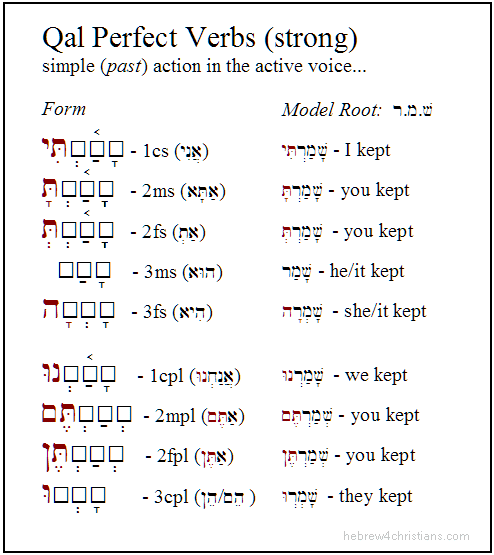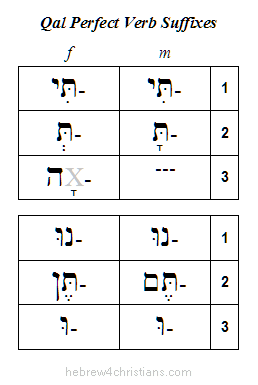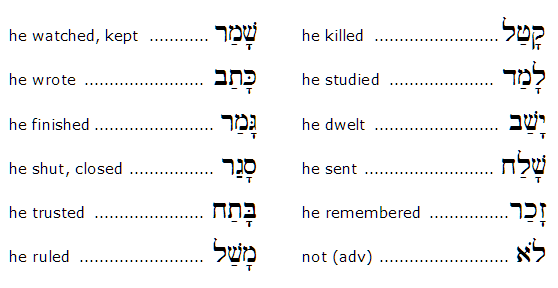|
The Qal Stem...
The most basic stem from the verbal root is called the Pa'al (ūżų╝ųĖūóųĘū£, based on the 3ms pattern) since it expresses the simple sense of the shoresh (e.g., "walk," "stand," "eat," and so on). Because it is the easiest and simplest form, it is called Qal (ū¦ųĘū£), meaning "light" or "simple." In most Hebrew lexicons and dictionaries, verbs are listed in the 3rd person masculine singular of the Qal (when it exists).
General properties of the Qal stem include:
- Active Voice - the subject is agent of verb (e.g., "I guarded")
- Simple Aspect - the action of the verb is simple (i.e., not reflexive or causal). In the perfect tense, the action is completed or "perfected" (i.e., past), while in the imperfect tense, the action is ongoing or not completed (i.e., present or future).
The Perfect Conjugation
A conjugation is a set of inflected forms (of a given verb stem) based on person, gender, and number. The perfect conjugation is used to denote completed (i.e., "perfected") action. For now, simply think of the perfect conjugation as the past tense in the active voice. The perfect conjugation for Qal perfect verbs, then, is a set of verb forms containing root letters with vowel patterns and suffixes added to the verb to indicate gender, person and number. These suffixes follow the sounds of the personal pronouns you have studied.
Strong and Weak Verbs
As mentioned in the Introduction to Hebrew Verbal System, Hebrew verb roots are divided according to whether the verb is regular or irregular with respect to one (or more) of its letters. Regular verbs have no weak letters (i.e., gutturals) in the shoresh and therefore they are called "strong" verbs; weak verbs, on the other hand, have one or more guttural letters in the root. The root ū®ūü.ū×.ū© is strong since none of its letters is a guttural. In a Hebrew lexicon, ū®ūüū×ū© would be listed as shamar (ū®ūüųĖū×ųĘū©), that is, with the vowels for the 3rd person masculine singular (3ms) of the Qal Perfect conjugation added. This is known as the "lexical form" of the verb.
Again, infections of the Qal stem are made by adding suffixes to the verb. The following conjugation shows the suffixes added to shamar to form the Qal perfect:
 |
The following "diagnostic" table further summarizes the pattern changes of a strong verb in the Qal Perfect conjugation:
 |
Notes:
- The 3ms form has no suffix at all and entirely resembles the root ū®ūü.ū×.ū©. This is the lexical form of the root. Note the vowel pattern: Qamets- Patach.
- The form of the verb itself contains pronominal information, and I included the personal pronouns for reference purposes only. In other words, shamarti means "I guarded" without the use of the word ani (in fact, ani shamarti could mean "I myself guarded"). Learning the endings along with the pronouns is somewhat easier since the sounds of the pronouns resembles the suffixes.
- You simply must memorize this as a paradigm for the Qal perfect. The endings are the same for all perfect verbs.
- The first person forms for both genders (1cs) and plural (1cp) are the same. That is shamarti can be singular for either gender, as can shamanu.
- The third person plural form is also common (3cp) for both genders (shamru).
- Note the exact spelling and accent marks for each form.
- The endings (suffixes) for the Qal perfect are as follows:

- Be aware that the meaning of the perfect in Hebrew is more complex than the simple past tense in English. For instance, depending on context, shamar might mean "he guarded," "he did guard," "he has guarded," "he had guarded," etc. Moreover, a perfect with a prefixed Vav is sometimes translated in the future tense, especially when it occurs in a narrative (more about this later).
- The normal word order in Hebrew is: verb - subject - object.
|
|







